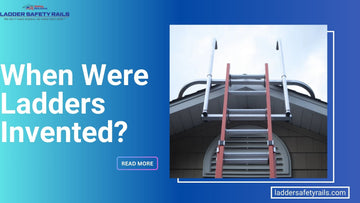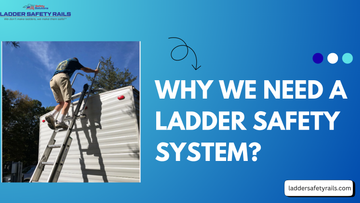
If you've ever climbed a ladder to clean gutters, inspect a roof, or string up holiday lights, you know that uneasy feeling when the ladder starts to wobble just a little too much. That’s exactly where a ladder roof stabilizer comes into play.
It's the one tool that can make a life-saving difference by giving your ladder a wider, more secure grip on the surface you're working on. Whether you're a professional roofer or a weekend DIY warrior, this is one accessory you shouldn’t climb without.
What Exactly Is a Ladder Roof Stabilizer?
A ladder roof stabilizer is a simple yet essential attachment that fits onto the upper part of an extension ladder. Its purpose is to increase stability by distributing your weight more evenly and providing a broader point of contact between the ladder and the roof or wall. Think of it as an extra set of arms for stability between the ladder and the surface on which the ladder is leaning against. It’s like upgrading from a tightrope to a solid bridge—way safer, and a lot less terrifying.
When you're dealing with uneven surfaces, slick siding, or fragile gutters. A good roof ladder stabilizer helps prevent your ladder from sliding sideways or backward, and more importantly, helps keep you from taking a nasty fall.
The best part? Most models are lightweight, easy to install, and compatible with a variety of ladders. So yes, adding one to your toolkit is a no-brainer.
Why Roof Work Without a Stabilizer Is Risky?
Ladders placed directly against a roof edge or gutter can cause all kinds of problems. They can crush or dent gutters, slide on smooth surfaces or even topple over from uneven pressure. That moment of imbalance can be the difference between finishing your project and ending up in the ER.
Using a roof stabilizer for ladder use helps eliminate these risks by creating a much broader and more stable contact area. It allows you to lean your ladder safely without worrying about damaging the structure or, worse, falling. Trust me—no project is worth compromising your safety.
Types of Ladder Roof Stabilizers:
Not all stabilizers are built the same, and that's a good thing. Depending on your task, one type of ladder stabilizer on roof jobs might suit you better than another. Some are compact and built for quick jobs, while others offer adjustable arms and foam padding for serious roof work.
Here’s a breakdown to help you choose the right one:
Common Ladder Roof Stabilizer Types
|
Type |
Best Use |
Pros |
|
Fixed Arm Stabilizer |
General roof access, basic tasks |
Easy to use, sturdy design |
|
Adjustable Arm Stabilizer |
Multi-surface and irregular jobs |
Custom fit, versatile use |
|
Stand-off Stabilizer |
Around windows, gutters, light fixtures |
Keeps ladder away from fragile surfaces |
Each of these has its perks, and your choice might depend on the kind of roof work you're doing. If you're climbing near delicate shingles or decorative trim, you’ll want something with wide, padded arms. For general roofing and maintenance, a ladder stabilizer for roof applications with a rigid structure and solid grip might be your best bet.
How a Ladder Roof Stabilizer Boosts Safety?
You wouldn’t drive without your seatbelt, right? The same logic applies here. An extension ladder roof stabilizer is your safety belt for roof work. It ensures your ladder doesn’t wiggle or tilt while you’re 15 feet in the air trying to juggle tools and keep your balance.

Here’s how it helps:
-
Wider base = greater stability:
A stabilizer expands the contact area, which helps prevent the ladder from tilting and makes the ladder feel much more secure.
-
Non-slip grip:
Most stabilizers come with rubber or foam padding that holds onto surfaces better than raw aluminum rails. That means less chance of the ladder slipping out from under you.
-
Even weight distribution:
Instead of pressing all your weight into a tiny strip of gutter or siding, your ladder leans gently on a broader, padded surface which keeps you balanced.
If you’ve ever looked up how to stabilize a ladder on a roof and found yourself overwhelmed by DIY hacks, just skip the guesswork and get a proper stabilizer.
How to Install a Ladder Stabilizer on Your Roof Ladder?
You don’t need an engineering degree to install a ladder stabilizer roof attachment. In fact, most of them are designed to be user-friendly, even for folks who only use the ladder twice a year on simple projects like cleaning the gutters.
Here’s a quick how-to:
- Pick the right stabilizer for your ladder model—most brands offer compatibility guides
-
Secure the stabilizer to the ladder’s top rungs or rails using clamps or bolts (these are usually included).
-
Adjust the width of the arms to fit your target surface, whether it’s a roof, wall, or corner.
-
Test the placement on a flat surface to make sure everything is locked in tight.
-
Carefully raise the ladder and lean it onto the roof or wall—ensure both arms are evenly touching the surface before climbing.
It’s that easy. Just remember to double-check that everything is tight and properly aligned before taking your first step up.
When and Where to Use a Ladder Roof Stabilizer?
You might be wondering: do I really need to use a stabilizer every time? While not mandatory for every job, using a ladder stabilizer for roof work is smart whenever you're climbing near delicate structures or dealing with unstable terrain.

Here are some great use-cases:
- Cleaning or repairing gutters
-
Accessing high roof areas
-
Power-washing siding
-
Hanging lights or decorations
-
Painting upper-level windows or trims
Basically, if your ladder is going higher than 6 feet and leaning against anything fragile or angled, do yourself a favor and attach a stabilizer. You’ll save time, reduce the chance of property damage, and most importantly, protect yourself.
Choosing the Best Ladder Stabilizer for Roof Safety
When it comes to choosing the best ladder stabilizer for roof tasks, not all models are created equal. You want something sturdy, easy to use, and suited to your specific type of work.
Look for these key features:
- Adjustable arms: These allow the stabilizer to work on different roof widths and slopes.
- Soft, non-marring tips: To avoid scratching gutters or damaging shingles.
- Tool-free installation: Because who wants to fumble with bolts 20 feet in the air?
- Weather-resistant materials: Aluminum and stainless steel are good bets here.
Some of the most reliable extension ladder stabilizer for roof jobs come from brands like Werner, Louisville, and Little Giant. Look at customer reviews, but also think about what you need most—whether that’s maximum reach, minimum weight, or somewhere in between.
Conclusion:
A ladder roof stabilizer isn’t just an accessory—it’s an essential safety tool for any roofer or contractor. By offering added balance, reducing ladder movement, and protecting surfaces like gutters and shingles, a stabilizer significantly reduces the risk of accidents. Whether you're working on steep pitches, fragile surfaces, or just need greater peace of mind, investing in a roof stabilizer is a smart move for both safety and efficiency.
Take your safety to the next level with Ladder Safety Rails. Our stabilizer is designed to make accessing elevated surfaces safer and more convenient. We give you the confidence to climb, work, and descend with stability.
Visit us and shop today to experience the difference.
FAQs:
-
How to stabilize a ladder on a metal roof?
Stabilizing a ladder on a metal roof requires extra caution because metal is notoriously slick. The key is to use a ladder roof stabilizer with rubberized or padded arms that can grip the surface without slipping.
-
Can I use ladder stabilizer on shingle roof?
Yes, a ladder stabilizer for roof jobs helps distribute the weight of the ladder across a wider area, preventing concentrated pressure that could crack or damage shingles.
-
How stabilize ladder on sloped roof?
Stabilizing a ladder on a sloped roof can be tricky, but it’s doable with the right tools. First, use a roof ladder stabilizer to secure the top of your ladder so it doesn’t slip or tilt. At the base, use a ladder leveler or place boards under the feet to make the ladder stand evenly.
-
Should I use ladder stabilizer for getting onto roof?
Definitely. Using a ladder stabilizer roof attachment when transitioning from a ladder onto the roof is one of the smartest safety moves you can make.
-
Should ladder stabilizer rest on roof?
That depends on the type of roof stabilizer for ladder use you have. Some models are designed to rest directly on the roof surface, while others are made to brace against the wall, fascia, or siding.
Read More Blog:





